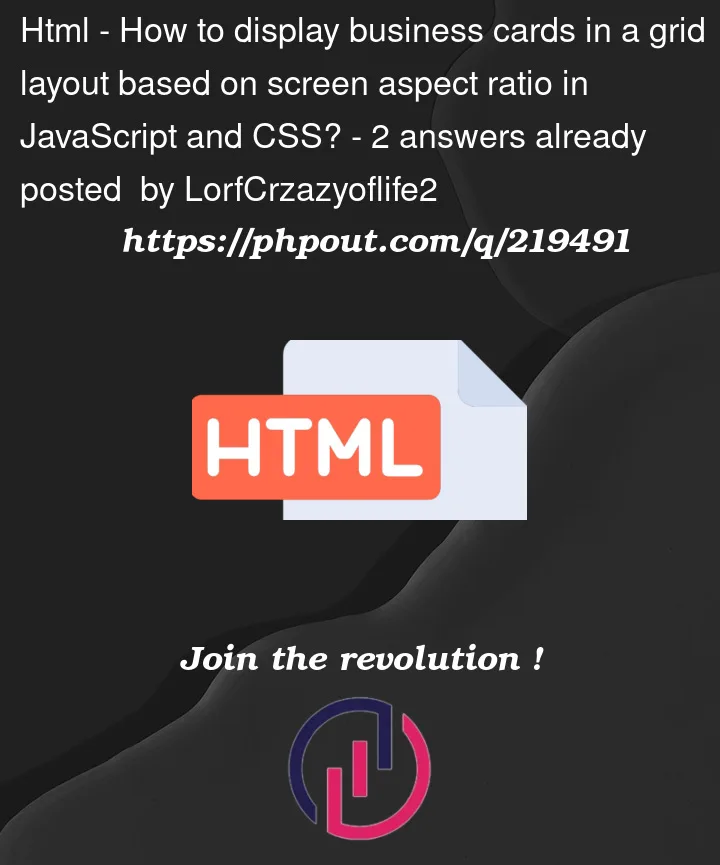I’m working on a web page that displays a list of business cards, each representing a company. I want to arrange these business cards in a grid layout based on the screen’s aspect ratio. On larger screens, I’d like the cards to be displayed in a grid with multiple cards per row, while on smaller screens, I want them to stack in a single column for better readability.
Here are the specific problems I’ve encountered:
The business cards are not arranging themselves in a grid layout on larger screens. They appear in a single column even when there is enough space to display multiple cards per row.
On smaller screens, the business cards stack in a single column, which is good, but they are not properly centered, and there’s excessive white space on the sides.
I have attempted to use CSS Grid and media queries to achieve the desired layout, but my implementation doesn’t seem to be working correctly.
I’ve tried adjusting the grid-template-columns and grid-gap properties in the CSS, but the cards still don’t arrange as expected.
I’m currently testing the webpage on Google Chrome (version 99.0) on a Windows PC with a 1920×1080 screen resolution.
Here’s a snippet of my HTML code for displaying the business cards:
<div class="search-box">
<select id="search-name" class="search-select">
<option value="">Select a Company</option>
<option value="Abernathy Defence & Aerospace">Abernathy Defence & Aerospace</option>
<option value="Aeronautico Torricelli">Aeronautico Torricelli</option>
<option value="Baltin Aerospace">Baltin Aerospace</option>
<!-- Add more companies here... -->
</select>
<select id="search-category" class="search-select">
<option value="">Select a category</option>
<option value="Tanks">Tank</option>
<option value="Aerospace">Aerospace</option>
<!-- Add more categories here... -->
</select>
<select id="search-location" class="search-select">
<option value="">Select a location</option>
<option value="Baltin">Baltin</option>
<option value="Helvery">Helvery</option>
<option value="UPA">UPA</option>
<!-- Add more locations here... -->
</select>
<button onclick="searchBusinesses()" class="search-btn">Search</button>
</div>
<div class="resultsDiv">
<div id="results">
</div>
</div>
And here’s a snippet of my JavaScript code for dynamically creating the business cards:
const businesses = [
{ name: "Abernathy Defence & Aerospace", category: "Aerospace", location: "UPA", logo: "ADA.png" },
{ name: "Aeronautico Torricelli", category: "Aerospace", location: "Helvery", logo: "torricelli.png" },
{ name: "Baltin Aerospace", category: "Aerospace", location: "Baltin", logo: "baltin.png" },
{ name: "Bos Industries", category: "Arms", location: "ARC", logo: "bos.png" }
// Add more businesses here...
];
function searchBusinesses() {
const categoryInput = document.getElementById("search-category").value;
const locationInput = document.getElementById("search-location").value;
const nameInput = document.getElementById("search-name").value;
const filteredBusinesses = businesses.filter(business =>
business.category.toLowerCase().includes(categoryInput.toLowerCase()) &&
business.location.toLowerCase().includes(locationInput.toLowerCase()) &&
business.name.toLowerCase().includes(nameInput.toLowerCase())
);
displayResults(filteredBusinesses);
}
function displayResults(businesses) {
const resultsDiv = document.getElementById("results");
resultsDiv.innerHTML = '';
if (businesses.length === 0) {
resultsDiv.innerHTML = '<p>No businesses found.</p>';
} else {
businesses.forEach(business => {
const card = createBusinessCard(business);
resultsDiv.appendChild(card);
});
}
}
function createBusinessCard(business) {
const card = document.createElement("div");
card.className = "business-card";
if (business.logo) {
const logoImg = document.createElement("img");
logoImg.src = business.logo;
logoImg.alt = business.name + " Logo";
card.appendChild(logoImg);
}
const nameHeading = document.createElement("h2");
nameHeading.textContent = business.name;
card.appendChild(nameHeading);
const categoryParagraph = document.createElement("p");
categoryParagraph.textContent = "Category: " + business.category;
card.appendChild(categoryParagraph);
const locationParagraph = document.createElement("p");
locationParagraph.textContent = "Location: " + business.location;
card.appendChild(locationParagraph);
return card;
}
// Call displayResults with the businesses array to display all companies at the start
document.addEventListener("DOMContentLoaded", () => {
displayResults(businesses);
});
and my css:
/* Business Cards Grid */
.resultsDiv {
display: grid;
grid-template-columns: repeat(auto-fill, minmax(300px, 1fr));
grid-gap: 20px;
}
.business-card {
border: 1px solid #ccc;
padding: 20px;
margin-bottom: 20px;
}
.business-card img {
max-width: 100%;
height: auto;
margin-bottom: 10px;
}
.business-card h2 {
font-size: 24px;
margin-bottom: 10px;
}
.business-card p {
margin-bottom: 5px;
}
I’m looking for guidance on how to modify my CSS and JavaScript code to achieve the desired grid layout on larger screens and a single-column layout on smaller screens. Any help is appreciated!




2
Answers
You need to use media queries to apply different CSS rules at different screen sizes. See the below example, press "run this code snippet" and the click the "full page" link and resize your browser window
This is a classic CSS grid use case, no media queries required. https://css-tricks.com/a-responsive-grid-layout-with-no-media-queries/